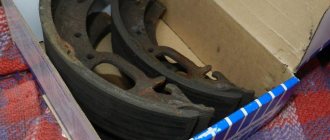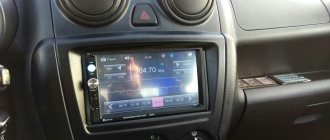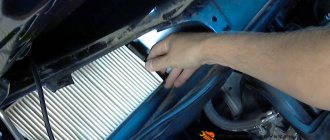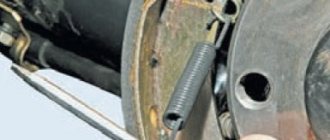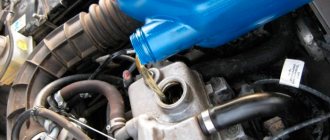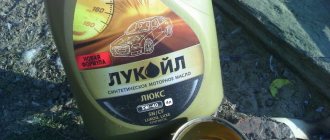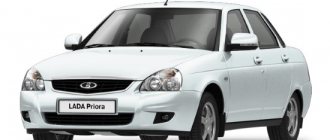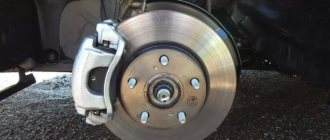This type of repair is not difficult. And if you follow this algorithm, then anyone whose hands grow from the right place can change the pads on a VAZ 2110.
The first step is to determine when to change the pads?
So, the front brake pads on a VAZ of the tenth family last approximately 35-50 thousand km. Therefore, if you have driven a lot more on them, no doubt replace them as soon as possible, because this is a guarantee of your safety. Some Schumachers manage to destroy the pads even faster, so you should monitor the thickness of the friction linings; they should be no thinner than 1.5 mm.
What you will need for this repair of a VAZ 2110: 1. Jack 2. Wheel nut wrench 3. Pliers 4. “17” wrench 5. “13” wrench 6. New front pads (catalog number: 21100-3501080-00)
First of all, jack up the car and remove the wheel. Then we bend the edge of the locking plate on the lower bolt of the wheel cylinder (use pliers). We unscrew the bolt from below using a wrench set to “13”; at the same time you need to hold the guide pin using an open-end wrench set to “17”. Pull out the bolt and plate.
Use a screwdriver to pry the caliper and cylinder up. Remove the front brake pads of the VAZ.We install the pads in the same way. Take the time to clean the places where they are installed from dirt. Press the piston into the cylinder using pliers. Or install the inner block and lower the bracket down to its normal position. Using a screwdriver, we move the bracket resting on the brake disc, thereby recessing the piston. (The screwdriver must be inserted into the caliper hole.)
When the pads are replaced and the wheel is put in place, you should depress the brake pedal several times until it stops. This is necessary to set the pistons to the working position. Don't forget to check the brake fluid and top it up if there is a shortage. Don't replace the pads on just one side, even if they aren't as worn on the other side. Since this can lead to your VAZ 2110 moving to the side when braking.
For clarity, the process of replacing pads is presented in the video:
Occasionally. It is precisely this temporary concept that can be applied when an answer to the question of how long to change brake pads is required. But technology does not tolerate approximate time frames. Some parts and technical fluids of a car have a certain time or operational framework, for example, it is recommended to replace brake fluid every 1-3 years or 30-40 thousand km. mileage
Articles of brake pads Lada Granta
Let's denote that the Granta's brake circuit is presented in a classic style: front disc and rear drum pads. This type/scheme was borrowed from Kalina, Priora, and earlier models.
| № | Article/OEM/brand | Price, rub.)* |
| 1. | Original catalog items 21100-3501080 | from 900 |
| 2. | 21100-3501089 | from 1200 |
| 3. | Disc TRW LADA Granta Article: GDB1384 | from 1450 |
| 4. | rear TRW Granta, Kalina, Datsun art. GS8210 | from 1300 |
| 5. | Allied Nippon ADB2794 (set) | from 3200 |
| 6. | Allied Nippon ADB2795 with calipers from Lada Priora 2110 | from 1100 |
| 7. | Allied Nippon ADB0173 | from 1100 |
| 8. | Rear brake pads Grant Sport / Kalina article number: 21905-3502080-87 | from 1100 – 1200 |
| 9. | Front brake pads LADA Granta Sport / LADA Kalina-2 Sport | from 1200 |
*Prices are current as of September 18, 2018.
Related link:
Replacing the Lada Granta generator bracket
The list presented is not exhaustive and is for informational purposes only. The manufacturer allows the purchase and subsequent installation of components not listed in the list. The main requirement for parts is quality workmanship and professional installation. Among foreign analogues, Lada Granta liftback brake pads are in high demand:
- BOSCH 0 986491700, 0 986495214;
- ICER 181308;
- Lucas – Girling E9 90R-01111/479;
- LYNXauto BD-4601, LYNXauto BD-4605;
- FENOX BP40005O7;
- FERODO FDB527;
- TRW 21170.
How do you know when it's time to change your brake pads?
The safety of a car directly depends on the serviceability of all systems in the car. While many drivers regularly check the level of oil, antifreeze, brake fluid, and the condition of the steering and wheels, the wear of the brake pads usually manifests itself with a nasty whistle and deterioration in braking properties. Pads are consumables that have their own service life and replacement schedule. Let's figure out how long brake pads last, what they are made of, what their service life is, and the reasons for their early failure.
Often the question “at what mileage should I change the brake pads” arises due to the lack of clear information from the manufacturer. So, the maintenance schedule for my car (Nissan Note 1.4) states that the entire brake system, including the pads, is checked at every maintenance, faults are eliminated or replaced if necessary. A cunning dealer, in this case, may insist on changing the pads at every maintenance.
What material are the pads made of?
All types of brake pads are the same in design: they are a metal plate with a friction coating applied to the surface. The composition can vary greatly, so the main varieties are distinguished:
- The friction layer consists of a metal, most often copper, mesh and graphite filling. Such semi-metallic pads have good heat dissipation, but are noisy and wear out quickly.
- metal in the coating is less than 30%, the rest is made up of organic fillers (glass, graphite, Kevlar). More efficient and less noisy.
- Made entirely of composite materials, they have good braking properties and are silent, but their service life will be even shorter.
- Fully ceramic pads are made of mineral fibers sintered together with filler and a small amount of copper. The lightest, most effective and durable, but also the most expensive.
Differences in replacement times for front and rear pads
Most modern cars have disc brakes at the front and drum brakes at the rear. Rear drum brakes have a longer service life than disc brakes. This is due to their design features - less dirt and dust gets into closed drums, the contact area of the pads with the braking surface is higher than that of discs, and also because they experience less load during the braking process.
On average, the service life of drum brakes is 2 or 3 times longer than that of disc brakes.
This leads to the conclusion that the rear and front pads are changed at different times, independently of each other.
After how many kilometers do you need to change brake pads? Replacement schedule for the most popular car models
The most common materials for friction linings are compounds with low metal content. Such pads are supplied to the assembly line of suppliers VAZ, Ford, Renault and other popular brands. How often replacement should be made for its models, the manufacturer determines the following intervals:
For front-wheel drive VAZ cars (Kalina, Granta, tenth family) - a general regulation has been established for how long to change the pads due to the similarity of the design and weight of the car. The minimum thickness of the abrasive layer is not less than 1.5 mm, and the average resource for the front ones is 20-40 thousand km and 80-140 thousand km for the rear ones. All of them are equipped with a wear indicator, so the need for replacement can be determined visually.
Hyundai Solaris does not have a regulated service life for the front pads; in practice, it is 25-30 thousand km for the version with an automatic transmission and a little more for a car with a manual transmission. The rear ones are 2 times longer.
For Ford Focus, it is recommended to replace the front pads at 60 thousand km or earlier if there is external damage or unacceptable wear.
On Renault Logan, the front brake pads can easily last 50-60 thousand km, while the rear brake pads in drum brakes will not require replacement until 100-120 thousand km.
After how many kilometers to change the brake pads in each specific case is determined by the driving style, the presence of an automatic transmission and electronic assistants such as ABS and ESP, which interfere with the control of the car by braking one or another wheel.
When taking care of your car, don't forget about the battery. And we’ll tell you how to choose a battery.
Do you have an expensive purchase coming up? Instructions on how not to buy a pig in a poke when buying a used car.
Looking for a cheaper car? List of the cheapest models in the world.
Main reasons for accelerated wear
Why do some owners' pads become unusable after only 10 thousand km, while another with the same model of car easily drives three times that distance? Wear is a very subtle parameter, depending on many factors:
- Vehicle driving mode – city or highway. In city traffic with frequent stops, the load on the brakes is higher than when driving freely on the highway. At what mileage the pads will wear to a minimum will depend on the routes taken.
- How often the replacement will be done depends on your driving style. A quiet ride helps to increase service life, while aggressive driving leads to frequent overheating and early wear of both discs and pads.
- Malfunction of the rear brake circuit. In this case, the front brakes have an increased load. If the rear of the car is additionally loaded, the force is distributed more evenly, and accordingly, the mileage of the front and rear pads increases.
- In the off-season, all parts of the brake system will be exposed to unfavorable climatic factors (moisture, dirt, ice), and in winter they will also be exposed to aggressive chemicals, which also does not extend service life. Those. The more often you drive in bad weather, the lower the resource.
- The presence in the car of complex electronic assistants that simulate the effect of differential locking by braking the wheel reduces the life of the pads.
What you need to know about Granta Sport pads
In the Sport modification, all four calipers are disc type. Friction linings are metallic and semi-metallic. Ceramic and organic friction linings are not installed on the Lada model. The difference between the last two types is the presence of ceramic and Kevlar fiber.
There is no need to mention the advantages of organics and ceramics, since everyone knows that they are developed using the most modern technologies and provide maximum braking effect. The exorbitant cost is a significant drawback, which for many becomes a stumbling block.
Grant brake pad life
The manufacturer in the operating manual indicates a replacement interval of 30,000 km. Taking into account the conditions of use of the machine, the quality of spare parts, and climatic temperatures, we reduce the period for replacing brake pads on Grant by a third.
To maintain the brake system in good condition, it is enough to carry out maintenance every 15,000 km. If defects or damage are found, replace with new elements.
How to choose and which ones are better to buy brake pads for Granta
The supply of brake system elements for Grant is carried out by. Specialization: trucks and cars. Since the end of 2012, JSC TIIR has been supplying front overlays made of composite material (1118-3501090). The peculiarity of the components is the absence of anti-creaking plates in the design. A special mastic is applied to the back side to suppress noise, vibrations, and squeaks.
The technology showed a number of shortcomings and in 2013 TIIR supplied new pads under the index (2192-3501090-10). They are also made of composite material under the number TIIR-299. Anti-squeak plates “Nulok” for Lada Granta are installed on the outside. The rear circuit is equipped with disc-type pads (21920-3502090-10). Components are also supplied by JSC TIIR. The number of the composite material TIIR is 444.
Related link:
Expert advice on replacing the clutch cable on a Lada Grant
Diagnostics of friction lining wear level
Most modern cars are equipped with special digital wear sensors. When the programmed level is reached, an indicator light is activated on the central instrument panel, indicating a breakdown of the brake circuit.
Unfortunately, the Lada is not yet equipped with digital sensors; you need to navigate by the actual thickness of the body of the lining. The maximum permissible threshold for using the body is 1.5 mm. Above the specified limit, the operation of the technical device is not safe. The degree of wear can be determined by removing each wheel and measuring the thickness with a caliper.
Alternative option: turn the steering wheel to the extreme left/right position, visually assess the thickness without resorting to dismantling work. The above recommendation only applies to the front circuit. For rear wheels, unconditional removal of discs.
Search
Front and rear replacement brake pads for Granta Lada
The front and rear brake pads can be operated to a thickness of more than 1.5mm, which is a smaller value (a value of more than 1.5mm is the same as the front and rear pads). With the lowest Granta Lada , it is likely that the rubber o-rings installed on the pistons come out of the sealing field located in the cylinder cavity in the brake mechanism. Relieving pressure in the seal will cause brake water to leak into the external environment and lead to breakdown and ineffective operation of the vehicle's brakes.
To ensure that old pads are replaced with new ones, replace them with 1.5mm wear. It is enough to replace 5.7 mm. The fact is that during prolonged operation in the extreme position of the piston, the previously working sealing surfaces may become clogged with deposits, which will not allow the piston to return to its original working position in the brake cylinder to a position corresponding to the thickness. from new brake pads.
Typical causes of wear on brake system components
- Long-term operation without intermediate prevention;
- Mechanical damage to the caliper or steering knuckle, resulting in deformation of the lining;
- Deformation, and as a result, creaking of brake pads on Grant;
- Purchase and subsequent installation of low quality parts;
- Violation of installation technology;
- Aggressive driving style of a vehicle;
- Insufficient amount of fluid in the expansion tank of the master cylinder;
- Damage to the supply line DOT – 4;
- Working cylinder jammed.
Sequence of actions when replacing pads on Granta yourself
Front
- We place the car within the perimeter of the repair zone, squeeze the parking brake, and engage first gear. We fix the rear row of wheels with wheel chocks;
- Jack up the side and remove the wheel;
- We unscrew the upper and lower guides, move the caliper to the side, do not unscrew the line;
- Carefully pry up the anti-squeak plates with a screwdriver and remove the pads;
- We troubleshoot the caliper, clean it, and blow it out if necessary;
- We install new linings.
Related link:
Replacing the clutch sensor on the Lada Grant: expert advice
After replacing the front pads, check the level in the tank. It is located in the engine compartment. We carry out a similar procedure with the second wheel. Service center technicians recommend replacing the circuits at the same time. For example: front / rear, all four calipers. Subsequent replacement after 30,000 km.
Rear So, to change the rear brake pads on a Grant, do the following:
- fix the front wheels, do not release the parking brake;
- jack up the rear side, remove the wheel;
- tapping the rim evenly with a hammer to knock it off its seat;
- remove the pressure plate, spacer bar;
- unpin the base of the fixation, the ear of the handbrake cable;
- remove the old ones and install new friction linings;
- The mechanism is pinned in the reverse order.
Be sure to check the fluid level in the expansion tank and replenish the missing amount.
Rear pad service life
The braking system is designed in such a way that most of the load during braking is transferred to the front of the car - to the front pads. Based on this, the rear brake pads last a very long time. No specialist from a car dealership can tell you exactly how long a rear brake pad will last, but all because the following factors have a huge impact on its service life:
- driving style - a fast way of driving, where the driver constantly accelerates and brakes, will accelerate the wear of the pads;
- brake drum quality;
- other circumstances - for example, products that are used to sprinkle the road surface in winter have a destructive effect on friction linings.
If the operating conditions are favorable, then the rear block of the Lada Grant can last up to 60,000 km. However, when replacing a pad, you should focus on the condition of the lining, and not the total mileage of the car after installing the new pad. Pay attention to the thickness of the overlay. If it has worn down to 1.5 mm or has become even thinner or, much worse, has begun to peel off from the metal or chips and cracks have appeared, you need to urgently replace the rear pad of the Lada Grant to avoid unpleasant consequences.
When the lining has worn off and become smaller than 0.15 cm, the piston may leave the cylinder, resulting in brake fluid leakage and brake pad breakage.
Owner reviews of Grant brake pads
| № | Positive |
| 1. | Vitaly, 38 years old: since I am familiar with equipment, I fix numerous breakdowns myself. I rarely go to the service center. I didn’t expect that the factory brake linings on the Grant last so long (37,000 km). |
| 2. | Kirill, 39 years old: I work as a taxi driver, I drive many kilometers per shift. I often change brake pads, the reasons are obvious. I didn’t change traditions, I buy domestic ones. |
| 3. | Vyacheslav, 41 years old: the right cylinder jammed and had to be urgently repaired at a service station. The technician pointed out the need to replace the set of friction linings. The domestic manufacturer suits me quite well, my advice to car enthusiasts. |
| 4. | Alexander, 44 years old: frequent trips around the city greatly wear out the friction linings on the Grant. I carry out repairs myself. In the store I always buy “original” ones according to the catalog numbers from the instruction manual. |
| 5. | Mikhail, 35 years old: after the accident, the question of choosing a pad manufacturer arose. The standard ones are not the best, but they are enough for me, my positive review. |
| 6. | Vitaly, 42 years old: I recently carried out maintenance on the Grante and was pleasantly surprised by the service life of the pads. Mileage over 32,000 km. |
| Negative | |
| 1. | Nikolay, 35 years old: I didn’t like the efficiency of the brake circuit, so I replaced it with new ones from Renault Logan. The quality is immediately noticeable. |
| 2. | Vladlen, 33 years old: I practice tuning on Grant, improving everything little by little. The other day I installed a set of new Allied Nippon ADB2795 pads. Japanese quality is always at its best. |
Related link:
Replacing spark plugs on a Lada Grant. Which candles are better
Conclusion Replacing Grant brake pads with your own hands is not at all difficult; every car owner can do it. 15 minutes of time is enough and the functionality of the node is restored. A moderate driving style, original spare parts, DOT - 4 class fluid will increase the service life of the Lada Granta brake system by 10 - 15%. Which brake pads to put on the Grant - obviously original, factory ones.
New pads: comparison with old ones
The condition of old and new components is best conveyed using a photograph, where wear, changes in the thickness and contour of the element are clearly visible.
Wear on the brake part of the old pad leads to the formation of severe wear on the brake disc (every vehicle owner faces this problem).
Worn brake pads significantly increase the load on the discs, which soon crack. That is why replacing elements on a Grant, even with your own hands, will protect the brake discs and increase comfort while driving a car.
Possible causes of pad defects
If during braking the driver hears a sharp squeak even after replacing the pads, the cause of the problem is the poor quality of the fractional layer. At the first contact, it crumbles, negatively affecting the work with the brake discs. This problem often occurs on original parts of cars such as VAZ 2110 and Lada Kalina.
It happens that the driver installed new front parts of the brake system, but from the first days the squeak does not go away. Sometimes a certain amount of time must pass for the grinding process to occur. The plaque that is inherent in the pads forms during production and creates a squeak that disappears after several thousand kilometers.
Next, you should highlight the wear of the strips. On one side, the friction layer may be completely worn out, which leads to friction between the disc and the metal base of the element. On the other hand, the fault may be poor-quality fastening of the wear sensor. After installing new parts, the owner of a Lada Granta may observe a whistle at the slightest contact of the pads with the discs.
Note! Weather conditions also affect the performance of front brake pads. In autumn, increased air humidity causes an unpleasant sound when starting the brake system. In the winter season, condensation, which forms due to strong temperature changes, creates the same effect as high humidity. Severe frosts create a coating on the surface of the pads, which, after heating the disc, turns into condensation.
Sometimes the problem may not be with the pads, but with the brake system itself. Vibrations that cause a feeling of worn-out elements are created when certain mechanisms of the system malfunction. If after replacing the elements the unpleasant sounds do not disappear, you should contact a specialist to diagnose the brake system.


